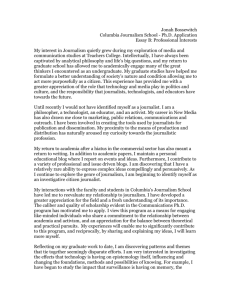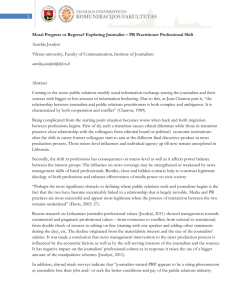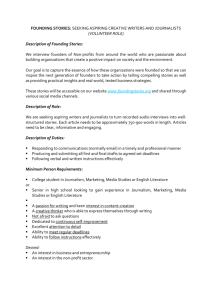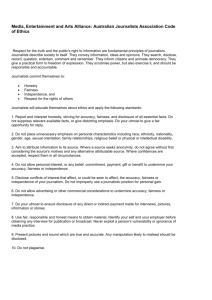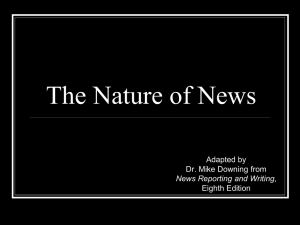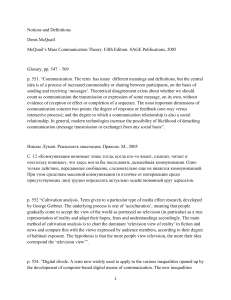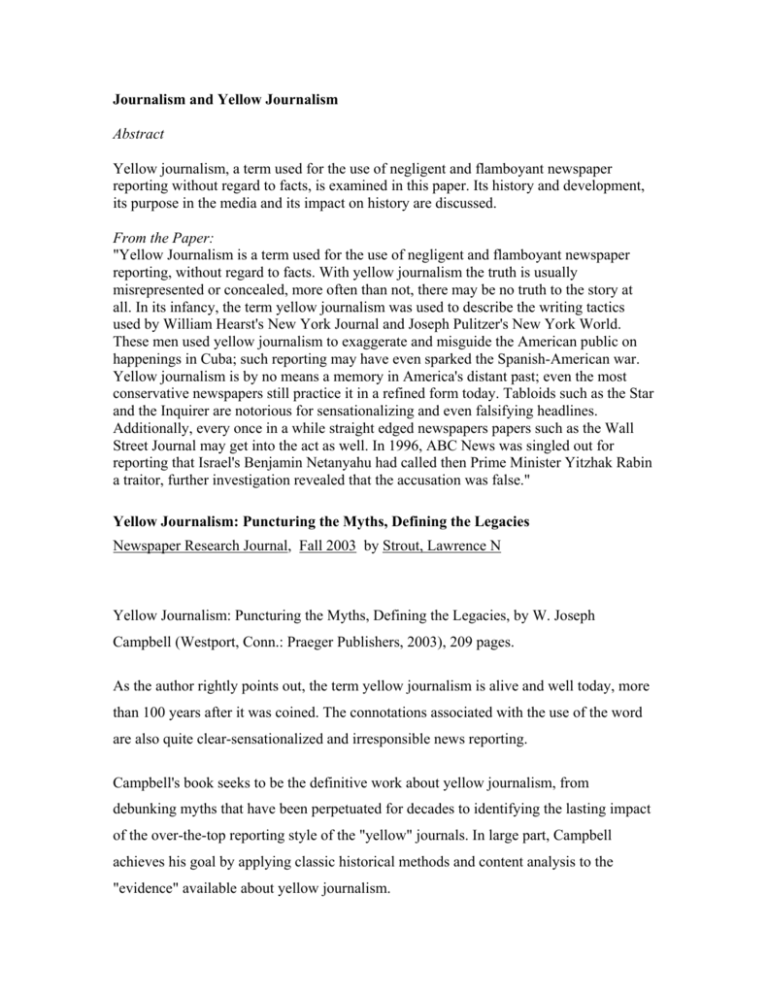
Journalism and Yellow Journalism
Abstract
Yellow journalism, a term used for the use of negligent and flamboyant newspaper
reporting without regard to facts, is examined in this paper. Its history and development,
its purpose in the media and its impact on history are discussed.
From the Paper:
"Yellow Journalism is a term used for the use of negligent and flamboyant newspaper
reporting, without regard to facts. With yellow journalism the truth is usually
misrepresented or concealed, more often than not, there may be no truth to the story at
all. In its infancy, the term yellow journalism was used to describe the writing tactics
used by William Hearst's New York Journal and Joseph Pulitzer's New York World.
These men used yellow journalism to exaggerate and misguide the American public on
happenings in Cuba; such reporting may have even sparked the Spanish-American war.
Yellow journalism is by no means a memory in America's distant past; even the most
conservative newspapers still practice it in a refined form today. Tabloids such as the Star
and the Inquirer are notorious for sensationalizing and even falsifying headlines.
Additionally, every once in a while straight edged newspapers papers such as the Wall
Street Journal may get into the act as well. In 1996, ABC News was singled out for
reporting that Israel's Benjamin Netanyahu had called then Prime Minister Yitzhak Rabin
a traitor, further investigation revealed that the accusation was false."
Yellow Journalism: Puncturing the Myths, Defining the Legacies
Newspaper Research Journal, Fall 2003 by Strout, Lawrence N
Yellow Journalism: Puncturing the Myths, Defining the Legacies, by W. Joseph
Campbell (Westport, Conn.: Praeger Publishers, 2003), 209 pages.
As the author rightly points out, the term yellow journalism is alive and well today, more
than 100 years after it was coined. The connotations associated with the use of the word
are also quite clear-sensationalized and irresponsible news reporting.
Campbell's book seeks to be the definitive work about yellow journalism, from
debunking myths that have been perpetuated for decades to identifying the lasting impact
of the over-the-top reporting style of the "yellow" journals. In large part, Campbell
achieves his goal by applying classic historical methods and content analysis to the
"evidence" available about yellow journalism.
Campbell first takes on the origin of the term yellow journalism, surmising from
meticulous research that the term first appeared in the New York Press in January 1897
and was "not directly" associated with the Hearst-Pulitzer rivalry over the cartoon
character the "Yellow Kid." One myth down, three to go.
ADVERTISEMENT
The assumption that the yellow journals appealed primarily to the lowbrow audiences of
the late 1800s and early 1900s is the next myth to fall. Cleverly using urban demographic
data to compare the cities where yellow journalism flourished to where it did not,
Campbell writes: "To characterize yellow journalism as appealing principally or
exclusively to downscale readers not only is elitist: It misrepresents the broad appeal of
the genre...." Two myths down, two to go.
The final two "debunked" myths relate to the same topic: The SpanishAmerican War.
First, the famous telegram allegedly sent from William Randolph Hearst to artist Frederic
S. Remington after Remington asked to return home because all was quiet in Cuba.
Hearst, so the story goes, replied: "Please remain. You furnish the pictures, and I'll
furnish the war." Campbell, in almost excruciating detail, attacks the source (James
Creelman) and identifies dispatches printed in the New York Journal at the time that
suggest the contrary. Campbell concludes that the story "deserves relegation to the closet
of historical imprecision." To attack the myth that the yellow journals played a large role
in the United States getting involved in the Spanish American War, Campbell looked at
the content of the yellow journals and researched the writings of key figures in the
McKinley administration. Again, he found no evidence that the SpanishAmerican War
was greatly influenced by the yellow press newspapers.
In debunking all of the four major myths about yellow journalism, Campbell's research is
thorough and sound and the evidence is clearly presented and backs up his assertions.
The second part of Campbell's book - Defining the Legacies-is less compelling.
Campbell embarked on a content analysis of newspapers in ten-year periods from 1899
through 1999. In the analysis, he uses a coding method that incorporates the major
characteristics of yellow journalism-such as multicolumn headlines, multicolumn
illustrations and using the newspaper's name in a headline-to track whether the
characteristics have lived on or died. Again, Campbell carries out the research in
meticulous detail, pointing out the strengths of the method used and conceding its
weaknesses while surmising, "American newspapers have become more uniform in
content" and "more graphically vivid while generally eschewing the most flamboyant
content variables associated with yellow journalism."
The final chapter of the book-still under Defining the Legacies-Campbell attempts to tie
the major trends associated with yellow journalism to today's journalism throughout the
United States and the world. From "development journalism" (the news media promoting
national unity and objectives), to public or "civic" journalism (journalists crusading to
better their communities), to crime-solving journalism, Campbell connects all of them
back to the yellow journalism era. His arguments are less impressive here because
several, if not all of the trends mentioned, could be tied to the Penny Press with the right
excerpts lifted from stories in Benjamin Day's New York Sun and James Gordon
Bennett's Neio York Herald.
But the weakness of one part of the book does not diminish the overall work of
Campbell. The well-researched book is laid out in clinical fashion, but it is not sterile to
read. In fact, the book is an interesting read from cover to cover while still being
formatted-with frequent use of bulleted lists-for easy use as a reference work. Yellow
Journalism: Puncturing the Myths, Defining the Legacies is a must read for everyone who
wants to know the "truth" about yellow journalism.
Strout is an associate professor and director of the Mass Communication Program at
Xavier University of Louisiana in New Orleans. He is author of the book Covering
McCarthyism: How the Christian Science Monitor handled Joseph R. McCarthy, 19501955, Greenwood Publishing Group, 1999.
Copyright Newspaper Research Journal, Department of Journalism, University of
Memphis Fall 2003
Provided by ProQuest Information and Learning Company. All rights Reserved
Journalism
From Wikipedia, the free encyclopedia
Journalism is a discipline of writing. News-oriented journalism is sometimes described
as the "first rough draft of history" (attributed to Phil Graham), because journalists often
did record important events, however producing news articles on short deadlines. While
under pressure to be first with their stories, news media organizations usually edit and
proofread their reports prior to publication, adhering to each organization's standards of
accuracy, quality, and style. Many news organizations claim proud traditions of holding
government officials and institutions accountable to the public, while media critics have
raised questions about holding the press itself accountable.
As for the future of journalism, computers are increasingly being used to support this
discipline. For example, Artificial Intelligence (AI) is used to support editorial
operations.
[edit] Reporting
Journalism's main activities include stating who, what, when, where, why and how, and
stating the significance and effects of certain events or trends. Journalism exists in a
number of media: newspapers, television, radio, magazines and, most recently, the World
Wide Web through the Internet.
The subject matter of journalism can be anything and everything, and journalists report
and write on a wide variety of subjects: politics on the international, national, provincial
and local levels, economics and business on the same four levels, health and medicine,
education, sports, hobbies and recreation, lifestyles, clothing, food, pets, sex and
relationships; journalists report on anything that news organizations think consumers will
read. Journalists can report for general interest news outlets like newspapers, news
magazines and broadcast sources; general circulation specialty publications like trade and
hobby magazines or for news publications and outlets with a select group of subscribers.
Journalists are usually expected and required to go out to the scene of a story to gather
information for their reports, and often may compose their reports in the field. They also
use the telephone, the computer and the internet to gather information. However, more
often those reports are written, and they are almost always edited in newsrooms, the
offices where journalists and editors work together to prepare news content.
Journalists, especially if they cover a specific subject or area (a "beat") are expected to
cultivate sources, people in the subject or area, that they can communicate with, either to
explain the details of a story, or to provide leads to other subjects of stories yet to be
reported. They are also expected to develop their investigative skills to better research
and report stories.
[edit] Print journalism
For more information about writing a news story, see News style
Print journalism can be split into several categories: newspapers, news magazines,
general interest magazines, trade magazines, hobby magazines, newsletters, private
publications, online news pages and others. Each genre can have its own requirements for
researching and writing reports.
For example, newspaper journalists in the United States have traditionally written reports
using the inverted pyramid style, although this style is used more for straight or hard
news reports rather than features. Written hard news reports are expected to be spare in
the use of words, and to list the most important information first, so that, if the story must
be cut because there is not enough space for it, the least important facts will be
automatically cut from the bottom. Editors usually ensure that reports are written with as
few words as possible. Feature stories are usually written in a looser style that usually
depends on the subject matter of the report, and in general granted more space (see
Feature-writing below).
News magazine and general interest magazine articles are usually written in a different
style, with less emphasis on the inverted pyramid. Trade publications can be more newsoriented, while hobby publications can be more feature-oriented.
[edit] Broadcast journalism
For more information about radio and television journalism, see News
broadcasting
Radio journalists must gather facts to present them fairly and accurately, but also must
find and record relevant and interesting sounds to add to their reports, both interviews
with people involved in the story and background sounds that help characterize the story.
Radio reporters may also write the introduction to the story read by a radio news anchor,
and may also answers questions live from the anchor.
Television journalists rely on visual information to illustrate and characterize their
reporting, including on-camera interviews with people involved in the story, shots of the
scene where the story took place, and graphics usually produced at the station to help
frame the story. Like radio reporters, television reporters also may write the introductory
script that a television news anchor would read to set up their story. Both radio and
television journalists usually do not have as much "space" to present information in their
reports as print journalists.
[edit] On-line (Cyber) journalism
The fast and vast growth of the Internet and World Wide Web has spawned the newest
medium for journalism, on-line (Cyber) journalism. The speed at which news can be
disseminated on the web, and the profound penetration to anyone with a computer and
web browser, have greatly increased the quantity and variety of news reports available to
the average web user.
The bulk of on-line(Cyber) journalism has been the extension of existing print and
broadcast media into the web via web versions of their primary products. New reports
that were set to be released at expected times now can be published as soon as they are
written and edited, increasing the deadline pressure and fear of being scooped many
journalists must deal with.
Most news websites are free to their users — one notable exception being the Wall Street
Journal website, for which a subscription is required to view its contents — but some
outlets, such as the New York Times website, offer current news for free but archived
reports and access to opinion columnists and other non-news sections for a periodic fee.
Another example is one of the largest on-line Urdu news sites, Al Qamar Online. The
founder of this news network, M. Haroon Abbas Qamar, is considered an authentic expert
on On- line (Cyber) journalism[citation needed]. Attempts to start unique web publications,
such as Slate and Salon, have met with limited success, in part because they do or did
charge subscription fees.
The growth of blogs as a source of news and especially opinion on the news has forever
changed journalism. Blogs now can create news as well as report it, and blur the dividing
line between news and opinion. The debate about whether blogging is really journalism
rages on (see blogging entry below).
[edit] Variations of journalism
[edit] Feature journalism
Newspapers and periodicals often contain features (see under heading feature style at
article news style) written by journalists, many of whom specialize in this form of indepth journalism.
Feature articles usually are longer than straight news articles, and are combined with
photographs, drawings or other "art." They may also be highlighted by typographic
effects or colors.
Writing features can be more demanding than writing straight news stories, because
while a journalist must apply the same amount of effort to accurately gather and report
the facts of the story, the reporter must also find a creative and interesting way to write
the article, especially the lead, or the first one or two paragraphs of the story. The lead
must grab the reader's attention yet accurately embody the ideas of the article. Often the
lead of a feature article is dictated by its subject matter. Journalists must work even
harder to avoid clichéd images and words when writing the lead and the rest of the
article.
In the last half of the 20th Century the line between straight news reporting and feature
writing blurred as more and more journalists and publications experimented with
different approaches to writing an article. Tom Wolf, Gay Talese, Hunter S. Thompson
and other journalists used many different approaches to writing news articles. Urban and
alternative weekly newspapers went even further blurring the distinction, and many
magazines fan more features than straight news.
Some television news shows experimented with alternative formats, and many TV shows
that claimed to be news shows were not considered as such by many critics, because their
content and methods did not adhere to accepted journalistic standards. National Public
Radio, on the other hand, is considered a good example of a good mixture of straight
news reporting, features, and combinations of the two, usually meeting standards of high
quality. Other U.S. public radio news organizations have achieved similar results. A
majority of newspapers still maintain a clear distinction between news and features, as do
most television and radio news organizations.
[edit] Sports journalism
•
For more information, see Sports journalism.
Sports journalism covers many aspects of human athletic competition, and is an integral
part of most journalism products, including newspapers, magazines, and radio and
television news broadcasts. While some critics don't consider sports journalism to be true
journalism, the prominence of sports in Western culture has justified the attention of
journalists to not just the competitive events of sports, but also to athletes and the
business of sports.
Sports journalism in the United States has traditionally been written in a looser, more
creative and more opinionated tone than traditional journalistic writing; the emphases on
accuracy and underlying fairness is still a part of sports journalism. An emphasis on the
accurate description of statistical performances of athletes is also an important part of
sports journalism.
[edit] Science journalism
* For more information, see Science journalism.
Science journalism is a relatively new branch of journalism, in which journalists'
reporting conveys information on science topics to the public. Science journalists must
understand and interpret very detailed, technical and sometimes jargon-laden information
and render it into interesting reports that are comprehensible to consumers of news
media.
Scientific journalists also must choose which developments in science merit news
coverage, as well as cover disputes within the scientific community with a balance of
fairness to both sides but also with a devotion to the facts.
Many, but not all, journalists covering science have training in the sciences they cover,
including several medical doctors who cover medicine.
[edit] Investigative journalism
* For more information, see Investigative reporting.
Investigative journalism, in which journalists investigate and expose unethical, immoral
and illegal behavior by individuals, businesses and government agencies, can be
complicated, time-consuming and expensive — requiring teams of journalists, months of
research, interviews (sometimes repeated interviews) with numerous people, longdistance travel, computers to analyze public-record databases, or use of the company's
legal staff to secure documents under freedom of information laws.
Because of its inherently confrontational nature, this kind of reporting is often the first to
suffer from budget cutbacks or interference from outside the news department.
Investigative reporting done poorly can also expose journalists and media organizations
to negative reaction from subjects of investigations and the public, and accusations of
gotcha journalism. When conducted correctly it can bring the attention of the public and
government problems and conditions that the public deem need to be addressed, and can
win awards and recognition to the journalists involved and the media outlet that did the
reporting.
[edit] Gonzo journalism
Gonzo journalism is a type of journalism popularized by the American writer Hunter S.
Thompson, author of Fear and Loathing in Las Vegas, Fear and Loathing: On the
Campaign Trail of '72, among other stories and books. Gonzo journalism is characterized
by its punchy style, rough language, and ostensible disregard for conventional journalistic
writing forms and customs. Gonzo journalism attempts to present a multi-disciplinary
perspective on a particular story, drawing from popular culture, sports, political,
philosophical and literary sources. Gonzo journalism has been styled eclectic or
untraditional. It remains a feature of popular magazines such as Rolling Stone magazine.
It has a good deal in common with on-line journalism (see above).
[edit] 'Celebrity' or 'People' journalism
Another area of journalism that grew in stature in the 20th Century is 'celebrity' or
'people' journalism, which focuses on the personal lives of people, primarily celebrities,
including movie and stage actors, musical artists, models and photographers, other
notable people in the entertainment industry, as well as people who seek attention, such
as politicians, and people thrust into the attention of the public, such as people who do
something newsworthy.
Once the province of newspaper gossip columnists and gossip magazines, celebrity
journalism has become the focus of national tabloid newspapers like the National
Enquirer, magazines like People and Us Weekly, syndicated television shows like
Entertainment Tonight, Inside Edition, The Insider, Access Hollywood, and Extra, cable
networks like E!, A&E Network and The Biography Channel, and numerous other
television productions and thouasands of websites. Most other news media provide some
coverage of celebrities and people.
Celebrity journalism differs from feature writing in that it focuses on people who are
either already famous or are especially attractive, and in that it often covers celebrities
obssessively, to the point of these journalists behaving unethically in order to provide
coverage. Paparazzi, photographers who would follow celebrities incessantly to obtain
potentially embarrassing photographs, have come to characterize celebrity journalism.
[edit] Role of journalism in society
In the 1920s, as modern journalism was just taking form, writer Walter Lippmann and
American philosopher John Dewey debated over the role of journalism in a democracy.
Their differing philosophies still characterize a debate about the role of journalism in
society and the nation-state.
Lippmann understood that journalism's role at the time was to act as a mediator or
translator between the public and policymaking elites. The journalist became the
middleman. When elites spoke, journalists listened and recorded the information, distilled
it, and passed it on to the public for their consumption. His reasoning behind this was that
the public was not in a position to deconstruct a growing and complex flurry of
information present in modern society, and so an intermediary was needed to filter news
for the masses. Lippman put it this way: The public is not smart enough to understand
complicated, political issues. Furthermore, the public was too consumed with their daily
lives to care about complex public policy. Therefore the public needed someone to
interpret the decisions or concerns of the elite to make the information plain and simple.
That was the role of journalists. Lippmann believed that the public would affect the
decision making of the elite with their vote. In the meantime, the elite (i.e. politicians,
policy makers, bureacrats, scientists, etc.) would keep the business of power running. In
Lippman's world, the journalist's role was to inform the public of what the elites were
doing. It was also to act as a watchdog over the elites as the public had the final say with
their votes. Effectively that kept the public at the bottom of the power chain, catching the
flow of information that is handed down from experts/elites.
Dewey, on the other hand, believed the public was not only capable of understanding the
issues created or responded to by the elite, it was in the public forum that decisions
should be made after discussion and debate. When issues were thoroughly vetted, then
the best ideas would bubble to the surface. Dewey believed journalists not only had to
inform the public, but should report on issues differently than simply passing on
information. In Dewey's world, a journalist's role changed. Dewey believed that
journalists should take in the information, then weigh the consequences of the policies
being enacted by the elites on the public. Over time, his idea has been implemented in
various degrees, and is more commonly known as "community journalism."
This concept of Community Journalism is at the center of new developments in
journalism. In this new paradigm, journalists are able to engage citizens and the
experts/elites in the proposition and generation of content. It's important to note that
while there is an assumption of equality, Dewey still celebrates expertise. Dewey believes
the shared knowledge of many is far superior to a single individual's knowledge. Experts
and scholars are welcome in Dewey's framework, but there is not the hierarchical
structure present in Lippman's understanding of journalism and society. According to
Dewey, conversation, debate, and dialogue lie at the heart of a democracy.
While Lippman's journalistic philosophy might be more acceptable to government
leaders, Dewey's approach is a better descriptor of how many journalists see their role in
society, and, in turn, how much of society expects journalists to function. Americans, for
example, may criticize some of the excesses committed by journalists, but they tend to
expect journalists to serve as watchdogs on government, businesses and other actors,
enabling people to make informed decisions on the issues of the time.
[edit] The Elements of Journalism
According to The Elements of Journalism by Bill Kovach and Tom Rosensteil, there are
nine elements of journalism. In order for a journalist to fulfill their duty of providing the
people with the information they need to be free and self-governing, they must follow
these guidelines.
1.
2.
3.
4.
5.
6.
7.
8.
9.
Journalism's first obligation is to the truth.
Its first loyalty is to the citizens.
Its essence is discipline of verification.
Its practitioners must maintain an independence from those they cover.
It must serve as an independent monitor of power.
It must provide a forum for public criticism and compromise.
It must strive to make the significant interesting and relevant.
It must keep the news comprehensive and proportional.
Its practitioners must be allowed to exercise their personal conscience.
[edit] Professional and ethical standards
Since the development of professional journalism at the beginning of the 20th Century,
journalists have been expected to follow a stringent code of journalistic conduct that
requires them to, among other things:
•
•
•
•
•
•
•
•
•
•
•
Use original sources of information, including interviews with people directly
involved in a story, original documents and other direct sources of information,
whenever possible, and cite the sources of this information in reports;
o For more information on using sources, see Journalism sourcing.
Fully attribute information gathered from other published sources, should original
sources not be available (to not do so is considered plagiarism; some newspapers
also note when an article uses information from previous reports);
Use multiple original sources of information, especially if the subject of the report
is controversial;
Check every fact reported;
Find and report every side of a story possible;
Report without bias, illustrating many aspects of a conflict rather than siding with
one;
Approach researching and reporting a story with a balance between objectivity
and skepticism.
Use careful judgment when organizing and reporting information.
Be careful about granting confidentiality to sources (news organizations usually
have specific rules that journalists must follow concerning grants of
confidentiality);
Decline gifts or favors from any subject of a report, and avoid even the
appearance of being influenced;
Abstain from reporting or otherwise participating in the research and writing
about a subject in which the journalist has a personal stake or bias that cannot be
set aside.
This was in stark contrast to the media climate prior to the 20th Century, where the media
market was dominated by smaller newspapers and pamphleteers who usually had an overt
and often radical agenda, with no presumpton of balance or objectivity. E.g., see (1).
[edit] Recognition of excellence in journalism
There are several professional organizations, universities and foundations that recognize
excellence in journalism. The Pulitzer Prize, administered by Columbia University in
New York City, is awarded to newspapers, magazines and broadcast media for excellence
in various kinds of journalism. The Columbia University Graduate School of Journalism
gives the Alfred I. duPont-Columbia University Awards for excellence in radio and
television journalism, and the Scripps Howard Foundation gives the National Journalism
Awards in 17 categories. The Society of Professional Journalists gives the Sigma Delta
Chi Award for journalism excellence. In the television industry, the National Academy of
Television Arts & Sciences gives awards for excellence in television journalism.
[edit] Failing to uphold standards
Such a code of conduct can, in the real world, be difficult to uphold consistently.
Journalists who believe they are being fair or objective may give biased accounts -- by
reporting selectively, trusting too much to anecdote, or giving a partial explanation of
actions. (See Media bias.) Even in routine reporting, bias can creep into a story through a
reporter's choice of facts to summarize, or through failure to check enough sources, hear
and report dissenting voices, or seek fresh perspectives.
As much as reporters try to set aside their prejudices, they may simply be unaware of
them. Young reporters may be blind to issues affecting the elderly. A 20-year veteran of
the "police beat" may be deaf to rumors of departmental corruption. Publications
marketed to affluent suburbanites may ignore urban problems. And, of course, naive or
unwary reporters and editors alike may fall prey to public relations, propaganda or
disinformation.
News organizations provide editors, producers or news directors whose job is to check
reporters' work at various stages. But editors can get tired, lazy, complacent or biased. An
editor may be blind to a favorite reporter's omissions, prejudices or fabrications. (See
Jayson Blair.) Provincial editors also may be ill-equipped to weigh the perspective (or
check the facts of) a correspondent reporting from a distant city or foreign country. (See
News management.)
A news organization's budget inevitably reflects decision-making about what news to
cover, for what audience, and in what depth. Those decisions may reflect conscious or
unconscious bias. When budgets are cut, editors may sacrifice reporters in distant news
bureaus, reduce the number of staff assigned to low-income areas, or wipe entire
communities from the publication's zone of interest.
Publishers, owners and other corporate executives, especially advertising sales
executives, can try to use their powers over journalists to influence how news is reported
and published. Journalists usually rely on top management to create and maintain a
"firewall" between the news and other departments in a news organization to prevent
undue influence on the news department. One journalism magazine, Columbia
Journalism Review, has made it a practice to reveal examples of executives who try to
influence news coverage, of executives who do not abuse their powers over journalists,
and of journalists who resist such pressures.
[edit] Reporting versus editorializing
Generally, publishers and consumers of journalism draw a distinction between reporting
— "just the facts" — and opinion writing, often by restricting opinion columns to the
editorial page and its facing or "op-ed" (opposite the editorials) page. Unsigned editorials
are traditionally the official opinions of the paper's editorial board, while op-ed pages
may be a mixture of syndicated columns and other contributions, frequently with some
attempt to balance the voices across some political or social spectrum.
The distinction between reporting and opinion can break down. Complex stories often
require summarizing and interpretation of facts, especially if there is limited time or
space for a story. Stories involving great amounts of interpretation are often labelled
"news analysis," but still run in a paper's news columns. The limited time for each story
in a broadcast report rarely allows for such distinctions.
[edit] Ambush journalism
Refers to aggressive tactics practiced by journalists to suddenly confront with questions
people who otherwise do not wish to speak to a journalist. The practice has particularly
been applied by television journalists, such as those on the CBS-TV news show 60
Minutes and by Geraldo Rivera, currently on the Fox News cable channel, and by
hundreds of American local television reporters conducting investigations.
The practice has been sharply criticized by journalists and others as being highly
unethical and sensational, while others defend it as the only way to attempt to provide
those subject to it an opportunity to comment for a report. Ambush journalism has not
been ruled illegal in the United States, although doing it on private property could open a
journalist to being charged with trespassing.
[edit] Gotcha journalism
•
For more information, see Gotcha journalism.
Refers to the deliberate manipulation of the presentation of facts in a report in order to
portray a person or organization in a particular way that varies from an accurate portrayal
based on balanced review of the facts available. In particular it is applied to broadcast
journalism, where the story, images and interviews are tailored to create a particular
impression of the subject matter.
It is considered highly unethical to engage in gotcha journalism. Many subjects of
reporting have claimed to have been subjected to it, and some media outlets are guilty of
deliberately biased reporting.
[edit] Legal status
For more information, see Freedom of the press
Journalists around the world often write about the governments in their nations, and those
governments have widely varying policies and practices towards journalists, which
control what they can research and write, and what press organizations can publish. Many
Western governments guarantee the freedom of the press, and do relatively little to
restrict press rights and freedoms, while other nations severely restrict what journalists
can research and/or publish.
Journalists in many nations have enjoyed some privileges not enjoyed by members of the
general publlic, including better access to public events, crime scenes and press
conferences, and to extended interviews with public officials, celebrities and others in the
public eye. These privileges are available because of the perceived power of the press to
turn public opinion for or against governments, their officials and policies, as well as the
perception that the press often represents their consumers. These privileges extend from
the legal rights of journalists but are not guaranteed by those rights. Sometimes
government officials may attempt to punish individual journalists who irk them by
denying them some of these privileges extended to other journalists.
Nations or jurisdictions that formally license journalists may confer special privileges and
responsibilities along with those licenses, but in the United States the tradition of an
independent press has avoided any imposition of government-controlled examinations or
licensing. Some of the states have explicit shield laws that protect journalists from some
forms of government inquiry, but those statutes' definitions of "journalist" were often
based on access to printing presses and broadcast towers. A national shield law has been
proposed.
In some nations, journalists are directly employed, controlled or censored by their
governments. In other nations, governments who may claim to guarantee press rights
actually intimidate journalists with threats of arrest, destruction or seizure of property
(especially the means of production and dissemination of news content), torture or
murder.
Journalists who elect to cover conflicts, whether wars between nations or insurgencies
within nations, often give up expectation to protection by government, if not giving up
their rights to protection by government. Journalists who are captured or detained during
a conflict are expected to be treated as civilians and to be released to their national
government.
[edit] Rights of journalists versus those of private citizens and organizations
Journalists enjoy similar powers and privileges as private citizens and organizations. The
power of journalists over private citizens is limited by the citizen's rights to privacy.
Many who seek favorable representation in the press (celebrities, for example) do grant
journalists greater access than others enjoy. The right to privacy of a private citizen may
be reduced or lost if the citizen is thrust into the public eye, either by their own actions or
because they are involved in a public event or incident.
Citizens and private organizations can refuse to deal with some or all journalists; the
powers the press enjoy in many nations often make this tactic ineffective or counterproductive.
Citizens in most nations also enjoy the right against being libeled or defamed by
journalists, and citizens can bring suit against journalists who they claim have published
damaging untruths about them with malicious disregard for the truth. Libel or defamation
lawsuits can also become conflicts between the journalists' rights to publish versus the
private citizen's right to privacy. Some journalists have claimed lawsuits brought against
them and news organizations — or even the threat of such a lawsuit — were intended to
stifle their voices with the threat of expensive legal procedings, even if plaintiffs cannot
prove their cases. This is referred to as the Chilling effect.
In many nations, journalists and news organizations must function under similar threat of
retaliation from private individuals or organizations as from governments. Criminals and
criminal organizations, political parties, some zealous religious organizations, and even
mobs of people have been known to punish journalists who speak or write about them in
ways they do not like. Punishments can include threats, physical damage to property,
assault, torture and murder.
[edit] Right to protect confidentiality of sources
For more information, see Protection of sources
Journalists' interaction with sources sometimes involves confidentiality, an extension of
freedom of the press giving journalists a legal protection to keep the identity of a source
private even when demanded by police or prosecutors; withholding sources can land
journalists in contempt of court, or jailtime.
The scope of rights granted journalists varies from nation to nation; in the United
Kingdom, for example, the government has had more legal rights to protect what it
considers sensitive information, and to force journalists to reveal the sources of leaked
information, than the United States. Other nations, particularly Zimbabwe and the
People's Republic of China, have a reputation of persecuting journalists, both domestic
and foreign.
In the United States, there has never been a right to protect sources in federal court. Some
states provide varying degrees of such protection. However, federal courts will refuse to
force journalists to reveal sources, unless the information the court seeks is highly
relevant to the case, and there's no other way to get it. Journalists, like all citizens, who
refuse to testify even when ordered to can be found in contempt of court and fined or
jailed.
[edit] Right of access to government information
Like sources, journalists depend on the rights granted by government to the public and,
by extension, to the press, for access to information held by the government. These rights
also vary from nation to nation (see Freedom of information legislation) and, in the
United States, from state to state. Some states have more open policies for making
information available, and some states have acted in the last decade to broaden those
rights. New Jersey, for example, has updated and broadened its Sunshine Law to better
define what kinds of government documents can be withheld from public inquiry.
In the United States, the Freedom of Information Act (FOIA) guarantees journalists the
right to obtain copies of government documents, although the government has the right to
redact, or black out, information from documents in those copies that FOIA allows them
to withhold. Other federal legislation also controls access to information (see Freedom of
information in the United States).

